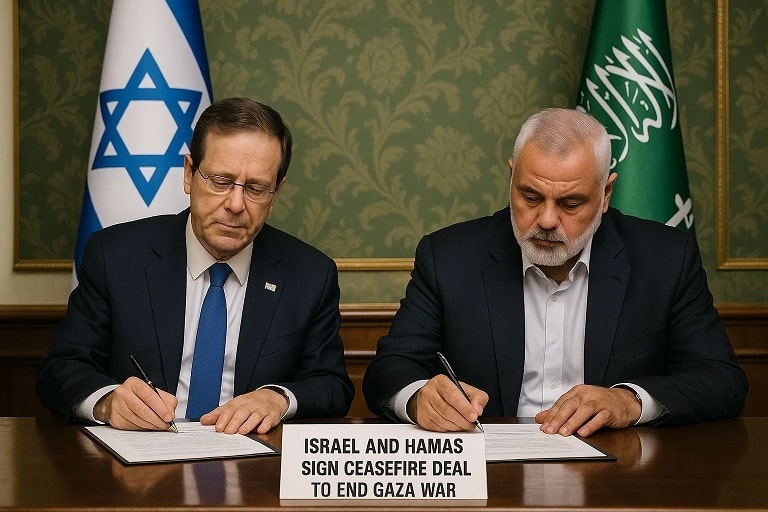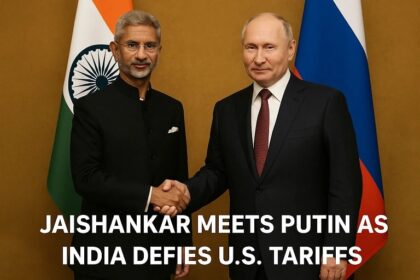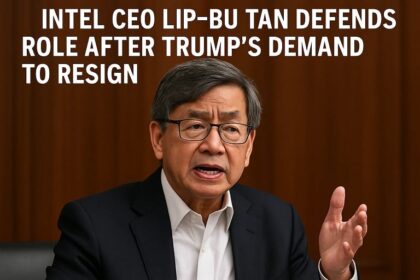Israel and Hamas Sign Ceasefire Deal to End Gaza War: A Historic Breakthrough After Two Years of Conflict
In a momentous development that has captivated the world, Israel and Hamas have signed a ceasefire agreement to end the devastating Gaza war, marking the first phase of a U.S.-brokered peace plan. Announced by President Donald Trump on October 9, 2025, the deal—mediated in Egypt by U.S., Qatari, and Egyptian officials—includes an immediate halt to hostilities, a phased hostage and prisoner exchange, and the opening of humanitarian corridors. This agreement comes after 24 months of intense fighting that has claimed over 40,000 lives, displaced millions, and drawn global condemnation. As Israeli forces prepare to withdraw from populated areas and aid surges into Gaza, the pact offers a fragile glimmer of hope for lasting peace, though challenges like disarmament and governance remain. This comprehensive overview explores the ceasefire’s details, immediate implications, historical backdrop, broader impacts, future pathways, and more, providing a thorough analysis of this pivotal moment in Middle East history.
Why the Israel-Hamas Ceasefire Deal Is a Turning Point
The signing of this ceasefire represents a rare convergence of diplomatic pressures, with Trump’s 20-point framework providing the blueprint for de-escalation. For Israel, it secures the release of remaining hostages held since the October 7, 2023, attacks, while allowing a strategic pause to regroup amid domestic protests. For Hamas, it halts the Israeli military offensive that has devastated Gaza, paving the way for aid and reconstruction. Globally, the deal alleviates humanitarian crises, eases regional tensions, and boosts U.S. diplomatic credibility, potentially unlocking $50 billion in reconstruction funds from Gulf states. However, its success hinges on mutual compliance and addressing root causes like the Israeli-Palestinian conflict, making it a fragile yet essential step toward stability in a volatile region.
Key Provisions of the Ceasefire Agreement
- Immediate Ceasefire: Hostilities to cease within 24 hours of Israeli cabinet ratification, expected by October 10, 2025.
- Hostage and Prisoner Exchange: Hamas to release all remaining hostages (living and deceased) within 72 hours; Israel to free an equivalent number of Palestinian prisoners.
- Troop Withdrawal: Israeli forces to pull back from populated Gaza areas to agreed lines, monitored by international observers.
- Humanitarian Aid: Surge in food, medicine, and fuel via corridors supervised by Egypt and Qatar.
- Phased Implementation: Future stages to cover Hamas disarmament, tunnel dismantling, and Gaza governance transitions.
Latest Events Surrounding the Ceasefire Signing
Trump’s Announcement and Egyptian Mediation on October 9, 2025
President Donald Trump declared the deal “signed off on the first phase” during a White House briefing on October 9, 2025, crediting months of U.S.-led talks in Cairo. Egyptian President Abdel Fattah el-Sisi confirmed the signing, noting it as a “victory for diplomacy” after intense negotiations involving Qatari envoys.
Israeli Cabinet Meeting and Hamas Response (October 9, 2025)
Israel’s security cabinet convened urgently on October 9, 2025, to ratify the agreement, with Prime Minister Benjamin Netanyahu hailing it as a “path to peace.” Hamas issued a statement affirming commitment, urging international guarantees for aid delivery and warning against violations.
Global Reactions and Aid Mobilization (October 9-10, 2025)
UN Secretary-General António Guterres praised the deal on October 9, 2025, calling for swift implementation to avert famine. Aid agencies like UNRWA announced a massive convoy rollout on October 10, 2025, targeting northern Gaza first.
The Gaza War and Previous Ceasefire Attempts
The current conflict erupted on October 7, 2023, with Hamas’s surprise attack on Israel, killing 1,200 and taking 250 hostages, prompting Israel’s retaliatory campaign that leveled Gaza and killed over 40,000. This war, the deadliest in decades, echoed the 2008-2009 Operation Cast Lead and 2014 Protective Edge, which saw temporary truces but no lasting peace. Earlier 2025 efforts, including a January 17, 2025, short-lived agreement, collapsed amid violations. Trump’s framework draws from the Abraham Accords (2020), blending economic incentives with security guarantees, while building on Biden-era mediations that faltered in 2024.
Timeline of Key Gaza Conflict Milestones
| Date | Event |
|---|---|
| October 7, 2023 | Hamas attacks Israel; war begins. |
| January 17, 2025 | Brief ceasefire collapses after violations. |
| September 2025 | Trump unveils 20-point peace framework. |
| October 9, 2025 | Israel-Hamas sign first-phase deal. |
Impacts of the Ceasefire Deal on Stakeholders
Humanitarian Relief and Reconstruction
The agreement opens doors for $10 billion in initial aid, potentially halving Gaza’s famine risk and enabling 1 million displacements to return. Reconstruction could take 5-10 years, focusing on housing and infrastructure.
Political and Security Ramifications
For Israel, it eases domestic pressure on Netanyahu but risks Hamas regrouping. Hamas gains legitimacy through negotiations, though disarmament demands could fracture its leadership. Regionally, it de-escalates Iran-Israel tensions.
Economic and Global Effects
Gulf funding could inject $50 billion into Gaza, boosting Middle East stability and oil markets. For the U.S., it enhances Trump’s legacy, potentially unlocking Arab-Israeli normalization.
Challenges and Risks
Fragile trust, with past violations, could unravel the deal; ongoing West Bank violence poses spillover threats.
Future Scopes: Pathways to Lasting Peace
Phased Implementation and Monitoring
Phase 2 (2026) may address disarmament and governance, with UN-led forces ensuring compliance. Success could lead to a two-state framework by 2030.
Reconstruction and Economic Revival
International donors aim for a $100 billion Gaza rebuild by 2035, focusing on tech hubs and tourism to foster peace dividends.
Broader Regional Diplomacy
The deal could expand Abraham Accords, incorporating Palestinian statehood talks and reducing proxy conflicts.
Potential Scenarios for 2030
- Optimistic: Full peace, thriving Gaza economy.
- Moderate: Extended truce with periodic flare-ups.
- Pessimistic: Collapse leads to renewed war.
Frequently Asked Questions (FAQs)
What does the ceasefire deal entail?
First phase includes immediate halt to fighting, hostage/prisoner swaps, troop withdrawals, and aid surges.
When does the ceasefire take effect?
Within 24 hours of Israeli ratification, expected October 10, 2025.
Who brokered the deal?
U.S. President Trump, with Egypt and Qatar mediation.
How many hostages remain?
Approximately 100, to be released in the first 72 hours.
What are the risks of failure?
Violations could restart hostilities; long-term issues like disarmament remain unresolved.
How will reconstruction be funded?
Gulf states and international donors, targeting $50 billion initially.
The Gaza Ceasefire: A Fragile Hope for Peace
The October 9, 2025, signing of the Israel-Hamas ceasefire deal offers a historic pause in a protracted war, promising relief and renewal if sustained.
Key Takeaways
- Phased Breakthrough: First stage halts fighting, exchanges captives.
- Diplomatic Win: Trump’s framework hailed globally.
- Humanitarian Surge: Aid to avert crisis.
- Path Forward: Challenges in disarmament, governance.












